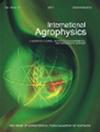Image-based modelling of the effect of s-metolachlor plus atrazine on the soaking kinetics of maize seeds
IF 1.7
4区 农林科学
Q2 AGRONOMY
引用次数: 0
Abstract
. Pre-emergent herbicides can have negative effects on maize seeds. The objective of this study was to model seed soaking curves through the processing of red-green-blue imagery of maize seeds under the influence of concentrations of s -metol-achlor + atrazine on both the soaking kinetics and primary root emission. Seeds were placed to soak for 114 h in Petri dishes containing aqueous solutions of a herbicide containing s -metolachlor (290 g l -1 ) + atrazine (370 g l -1 ) with the following concentrations: 0% (water only), 2, 5, 10, 20 and 50%, based on the recommended dose (4.0 l of the commercial product per hectare). The images were systematically taken from a flatbed scanner with artificial light control. The red excess index was adapted to improve image segmentation. From the binary masks applied, the soaking curves for each herbicide concentration were obtained using estimates of seed intumescence over time. The soaking curves were described by fitting Peleg’s model. The herbicide concentration has signifi cant effects on both the absorption rate and primary root emission; the absorption rate was reduced by 50%. A concentration of s -metolachlor (290 g l –1 ) + atrazine (370 g l –1 ) in aqueous solution that is above 20% can fully inhibit seed germination.s-甲草胺加阿特拉津对玉米种子浸泡动力学影响的图像建模
.紧急使用前的除草剂会对玉米种子产生负面影响。本研究的目的是通过处理玉米种子的红-绿-蓝图像,在s-metol achlor+阿特拉津浓度对浸泡动力学和一次根系排放的影响下,对种子浸泡曲线进行建模。将种子放入培养皿中浸泡114小时,培养皿中含有除草剂的水溶液,该除草剂含有s-甲草胺(290 g l-1)+阿特拉津(370 g l-2),浓度如下:0%(仅水)、2%、5%、10%、20%和50%,基于推荐剂量(每公顷4.0 l商业产品)。这些图像是从带有人造光控制的平板扫描仪上系统地拍摄的。采用红色过量指数来改进图像分割。从应用的二元掩模中,使用种子随时间膨胀的估计值获得了每种除草剂浓度的浸泡曲线。通过拟合Peleg模型描述了均热曲线。除草剂浓度对吸收速率和一次根排放都有显著影响;吸收率降低了50%。s-异丙草胺(290 g l–1)+阿特拉津(370 g l–2)在水溶液中的浓度高于20%可以完全抑制种子发芽。
本文章由计算机程序翻译,如有差异,请以英文原文为准。
求助全文
约1分钟内获得全文
求助全文
来源期刊

International Agrophysics
农林科学-农艺学
CiteScore
3.60
自引率
9.10%
发文量
27
审稿时长
3 months
期刊介绍:
The journal is focused on the soil-plant-atmosphere system. The journal publishes original research and review papers on any subject regarding soil, plant and atmosphere and the interface in between. Manuscripts on postharvest processing and quality of crops are also welcomed.
Particularly the journal is focused on the following areas:
implications of agricultural land use, soil management and climate change on production of biomass and renewable energy, soil structure, cycling of carbon, water, heat and nutrients, biota, greenhouse gases and environment,
soil-plant-atmosphere continuum and ways of its regulation to increase efficiency of water, energy and chemicals in agriculture,
postharvest management and processing of agricultural and horticultural products in relation to food quality and safety,
mathematical modeling of physical processes affecting environment quality, plant production and postharvest processing,
advances in sensors and communication devices to measure and collect information about physical conditions in agricultural and natural environments.
Papers accepted in the International Agrophysics should reveal substantial novelty and include thoughtful physical, biological and chemical interpretation and accurate description of the methods used.
All manuscripts are initially checked on topic suitability and linguistic quality.
 求助内容:
求助内容: 应助结果提醒方式:
应助结果提醒方式:


